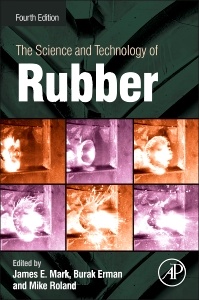Description
The Science and Technology of Rubber (4th Ed.)
Coordinators: Mark James E., Erman Burak, Roland Mike
Language: English
Subjects for The Science and Technology of Rubber:
Keywords
stress; strain; polymerization; elastomers; molecular theories; viscoelasticity; vulcanization
816 p. · 15x22.8 cm · Hardback
Description
/li>Contents
/li>Readership
/li>Biography
/li>Comment
/li>
1. Rubber Elasticity: Basic Concepts and Behavior
2. Polymerization: Elastomer Synthesis
3. Structure Characterization in the Science and Technology of Elastomers
4. The Molecular Basis of Rubberlike Elasticity
5. The Viscoelastic Behavior of Rubber
6. Rheological Behavior and Processing of Unvulcanized Rubber
7. Vulcanization
8. Reinforcement of Elastomers by Particulate Fillers
9. The Science of Rubber Compounding
10. Strength of Elastomers
11. The Chemical Modification of Polymers
12. Elastomer Blends
13. Thermoplastic Elastomers
14. Bioelastomers
15. Tire Engineering
16. Recycling of Rubbers
Index
Practicing engineers involved with materials science and research, specifically in polymer and elastomer science; professionals and practitioners in the rubber industry
Dr. Roland is head of the Polymer Physics Section in the Chemistry Division at the Naval Research Laboratory. After earning his doctorate in chemistry at Pennsylvania State University, he worked as a researcher at The Firestone Tire & Rubber Co. before joining NRL in 1986. He has over 370 peer-reviewed publications and holds 13 patents. Roland has won various awards for his research, including the Sparks-Thomas and Melvin Mooney Awards from the American Chemical Society and the Pure Science Award from the NRL Edison Chapter of Sigma Xi. He has served in editorial and advisory capacities on several journals, including technical editor of Rubber Chemistry & Technology. He is a Fellow of the Institute of Materials, Minerals, and Mining (UK).
- Provides a complete survey of elastomers for engineers and researchers in a unified treatment: from chemical aspects like elastomer synthesis and curing to the final applications of rubber, including tire engineering and manufacturing
- Contains important updates to several chapters, including elastomer synthesis, characterization, viscoelastic behavior, rheology, reinforcement, tire engineering, and recycling
- Includes a new chapter on the burgeoning field of bioelastomers




